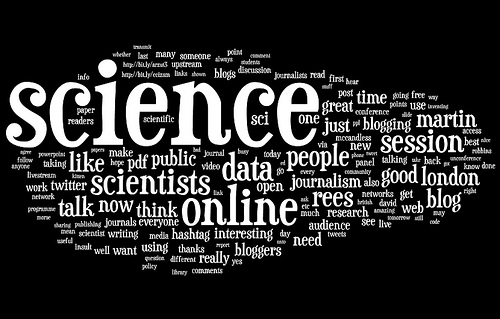The 3rd Annual Science Online London Conference took place last Friday and Saturday. For me it was again a fantastic event. Matt Brown is collecting all blog posts, pictures, videos, etc. over at this Nature Network post. As one of the organizers of the conference (mainly helping with the program) I was pretty nervous, and I have to admit that I didn’t sleep well Thursday and Friday. And much better Saturday.

Flickr photo by Mendeley.com with me on far left.
One important reason to go to a conference is of course to meet the members of your community in real life. It was great to talk to many old friends again, and to meet for the first time in person people I knew from online interactions (Alex Knoll, Brian Mossop, David Dobbs, Matt Cockerill, Jen Mellinn, William Gunn and Jim Caryl and many others not mentioned here). Of course I also missed several friends that came to the first two conferences.
Of the many impressions of the conference I want to focus on one: Twitter.
Twitter has of course become a mainstream tool to follow conferences. Microblogging for the 2008 conference happened mainly on FriendFeed (the much better tool for conference microblogging and described in this PLoS Comp Biol paper). Every year has seen an increase in Twitter use, and both ScienceOnline2010 (#scio10) in January and last week’s conference produced more than 6000 tweets. Towards the end of the conference on Saturday the #solo10 hashtag was the #2 trend for London, right before #happbirthdaybeyonce. People not attending the conference were starting to drop in the conversation. We easily beat mainstream science conferences such as the American Society of Clinical Oncology Meeting (#asco10) that I attended earlier this year (almost 5000 tweets, but more than 30.000 attendees). Also interesting: more than 700 people used the #solo10 hashtag in their tweets, even though the conference had only 250 attendees (at least 140 of them with Twitter accounts, listed here). And some of those not attending were very active twitterers, particularly Bora Zivkovic (@BoraZ).

Simon Cockell has created a Wordle with the conference tweets, which gives a good idea of the topics discussed. The word PDF is a good example. Martin Robbins said in the Rebooting Science Journalism panel discussion that “The PDF is an insult to science…” (rightfully so), and this resulted in a longer discussion in the Twitter backchannel.
That same panel discussion also made the best use of Twitter as integral part of a session. Christine Ottery was monitoring the Twitter feed and provided feedback for the panelists. We used Twitterwalls for most sessions, but the speakers often did not use information.

Flickr photo by Mendeley.com
Twitter several times was also mentioned as an important discovery tool, and I agree that it has become of the best tools to discover interesting stuff, blog posts, papers, etc. I couldn’t attend the Recommendation Tools for Scientists session (with Kevin Emamy and Jason Hoyt), so I don’t know whether Twitter as recommendation tool was discussed there.
It would be interesting to do a more detailed analysis of the #solo10 tweets, e.g. by analyzing which sessions were the most tweeted, what were the most popular keywords and links, or by categorizing tweets into different categories. This could make an interesting session at the ScienceOnline2011 Conference next January – of course using some of the cool data visualization tricks that David McCandless showed us in his session.

